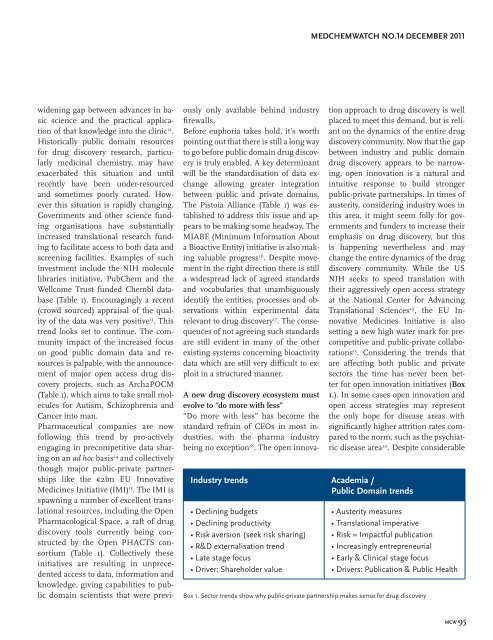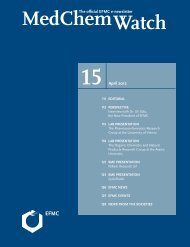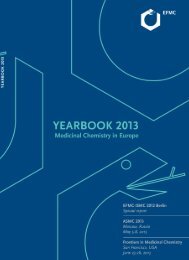You also want an ePaper? Increase the reach of your titles
YUMPU automatically turns print PDFs into web optimized ePapers that Google loves.
widening gap between advances in basic<br />
science and the practical application<br />
of that knowledge into the clinic 12 .<br />
Historically public domain resources<br />
for drug discovery research, particularly<br />
<strong>med</strong>icinal <strong>chem</strong>istry, may have<br />
exacerbated this situation and until<br />
recently have been under-resourced<br />
and sometimes poorly curated. However<br />
this situation is rapidly changing.<br />
Governments and other science funding<br />
organisations have substantially<br />
increased translational research funding<br />
to facilitate access to both data and<br />
screening facilities. Examples of such<br />
investment include the NIH molecule<br />
libraries initiative, PubChem and the<br />
Wellcome Trust funded Chembl database<br />
(Table 1). Encouragingly a recent<br />
(crowd sourced) appraisal of the quality<br />
of the data was very positive 13 . This<br />
trend looks set to continue. The community<br />
impact of the increased focus<br />
on good public domain data and resources<br />
is palpable, with the announcement<br />
of major open access drug discovery<br />
projects, such as Arch2POCM<br />
(Table 1), which aims to take small molecules<br />
for Autism, Schizophrenia and<br />
Cancer into man.<br />
Pharmaceutical companies are now<br />
following this trend by pro-actively<br />
engaging in precompetitive data sharing<br />
on an ad hoc basis 14 and collectively<br />
though major public-private partnerships<br />
like the €2bn EU Innovative<br />
Medicines Initiative (IMI) 15 . The IMI is<br />
spawning a number of excellent translational<br />
resources, including the Open<br />
Pharmacological Space, a raft of drug<br />
discovery tools currently being constructed<br />
by the Open PHACTS consortium<br />
(Table 1). Collectively these<br />
initiatives are resulting in unprecedented<br />
access to data, information and<br />
knowledge, giving capabilities to public<br />
domain scientists that were previ-<br />
ously only available behind industry<br />
firewalls.<br />
Before euphoria takes hold, it’s worth<br />
pointing out that there is still a long way<br />
to go before public domain drug discovery<br />
is truly enabled. A key determinant<br />
will be the standardisation of data exchange<br />
allowing greater integration<br />
between public and private domains.<br />
The Pistoia Alliance (Table 1) was established<br />
to address this issue and appears<br />
to be making some headway. The<br />
MIABE (Minimum Information About<br />
a Bioactive Entity) initiative is also making<br />
valuable progress 16 . Despite movement<br />
in the right direction there is still<br />
a widespread lack of agreed standards<br />
and vocabularies that unambiguously<br />
identify the entities, processes and observations<br />
within experimental data<br />
relevant to drug discovery 17 . The consequences<br />
of not agreeing such standards<br />
are still evident in many of the other<br />
existing systems concerning bioactivity<br />
data which are still very difficult to exploit<br />
in a structured manner.<br />
A new drug discovery ecosystem must<br />
evolve to “do more with less”<br />
“Do more with less” has become the<br />
standard refrain of CEOs in most industries,<br />
with the pharma industry<br />
being no exception 18 . The open innova-<br />
tion approach to drug discovery is well<br />
placed to meet this demand, but is reliant<br />
on the dynamics of the entire drug<br />
discovery community. Now that the gap<br />
between industry and public domain<br />
drug discovery appears to be narrowing,<br />
open innovation is a natural and<br />
intuitive response to build stronger<br />
public-private partnerships. In times of<br />
austerity, considering industry woes in<br />
this area, it might seem folly for governments<br />
and funders to increase their<br />
emphasis on drug discovery, but this<br />
is happening nevertheless and may<br />
change the entire dynamics of the drug<br />
discovery community. While the US<br />
NIH seeks to speed translation with<br />
their aggressively open access strategy<br />
at the National Center for Advancing<br />
Translational Sciences 19 , the EU Innovative<br />
Medicines Initiative is also<br />
setting a new high water mark for precompetitive<br />
and public-private collaborations<br />
15 . Considering the trends that<br />
are affecting both public and private<br />
sectors the time has never been better<br />
for open innovation initiatives (Box<br />
1.). In some cases open innovation and<br />
open access strategies may represent<br />
the only hope for disease areas with<br />
significantly higher attrition rates compared<br />
to the norm, such as the psychiatric<br />
disease area 20 . Despite considerable<br />
Industry trends Academia /<br />
Public Domain trends<br />
• Declining budgets<br />
• Declining productivity<br />
• Risk aversion (seek risk sharing)<br />
• R&D externalisation trend<br />
• Late stage focus<br />
• Driver: Shareholder value<br />
MEDCHEMWATCH NO.14 DECEMBER 2011<br />
• Austerity measures<br />
• Translational imperative<br />
• Risk = Impactful publication<br />
• Increasingly entrepreneurial<br />
• Early & Clinical stage focus<br />
• Drivers: Publication & Public Health<br />
Box 1. Sector trends show why public-private partnership makes sense for drug discovery<br />
MCW 95





